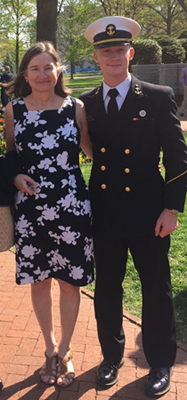Military Personnel Who Serve in Life and Death
Rutgers Robert Wood Johnson Medical School trains U.S. National Guard combat medics using donated cadavers of military veterans

The cadavers of military veterans are being used to prepare medics to treat the devastating injuries they will encounter when deployed through a unique collaboration between Rutgers Robert Wood Johnson Medical School and the United States National Guard.
Many of the cadavers were former military personnel who had decided to donate their bodies to science to train those who would be called on to help others after they were gone. They account for about 20 percent of the cadavers medics are working with in this program.
“It’s easy to work on a mannequin and not fully grasp the seriousness of what you are taking on. But working with real tissue, that experience is invaluable,” says Capt. Justin Howe, whose wife, Caitlin Howe, is an instructor in the medical school’s Department of Neuroscience and Cell Biology.
The idea for the pilot program came from Army Specialist Brian Ruane, a Rutgers graduate, who brought it to Caitlin Howe at the medical school.
“It will surely give this unit an advantage in the field,” says Howe.
The goal of the two-part session is to give medics a similar experience to what they would encounter in the field.
During the classroom portion of training, Howe showed the group graphic slides of wounded soldiers and a discussion ensued on how they were treated in the field with minimal supplies.
The team then moved on to the cadaver lab where medics were introduced to their first patients. The four-hour, hands-on training, focused on specific medical techniques: tourniquet application, wound packing, airway maintenance, needle chest decompression and chest tube placement, in addition to an overview of general anatomy.
Organizers say the voluntary event was structured around what the medics felt would be most valuable for them in the field.
“I feel strongly that military personnel should have every possible medical resource to support them when they deploy. When it seemed that I could help in this effort, I jumped at the chance.” – Siobhan Corbett
Siobhan Corbett, associate professor of surgery at Robert Wood Johnson Medical School, volunteered to apply her trauma and general surgery experience during the technical portion of the training.
“I felt proud as an American, to work with these soldiers who were from all walks of life and hoped that in some way, something I said or did will stick with them and help them should they need it in the future,” says Corbett.
As the mother of a son in the United States Naval Academy, Corbett felt an even more personal connection and responsibility to serve in this unique role. “I feel strongly that military personnel should have every possible medical resource to support them when they deploy. When it seemed that I could help in this effort, I jumped at the chance.”
Attendee Sgt. Marcus F. Moore agrees with Corbett. “With the ability to perform a mock procedure, I realized just how tough the human skin is. Also, being able to see the path of the larynx to the lung, gave me a better understanding of the placement of the airway interventions, what could obstruct the airway and how to bypass obstructions if needed,” says Moore. “The overall experience was outstanding. I feel that this class should become part of a mandatory training doctrine for medics.”
Training to become a National Guard combat medic includes basic combat training and a 16-week advanced individual training program. Many of the medics have physician assistant experience and some are emergency medical technicians.
Moore noted the benefits for all military personnel. “Some of us may never get deployment experience or real-world accounts of trauma patients. So a class of this magnitude helps keep the medic up-to-date with his/her knowledge of human anatomy and current techniques.”
Howe’s goal is to expand the program and make it an annual statewide event. “We have the experience, technology and resources. Next, is to apply for funding to make this program even more successful moving forward.”